Translate this page into:
Long-term effects of black seed and garlic oil on the offspring of two consecutive pregnancies in rats
-
Received: ,
Accepted: ,
This article was originally published by Elsevier and was migrated to Scientific Scholar after the change of Publisher.
Abstract
The present study was undertaken to assess the long-term consumption of the seeds of Nigella sativa L., also known as black seed and garlic by the female rats on the fecundity and gender ratio of their male and female offspring for two consecutive pregnancies, locomotory behavioural activities of offspring and on some important blood chemistry parameters of the offspring at adolescent age. The dose of black seed oil or garlic oil (0.8 ml per day) was administered orally and daily through gavage to the females until the weaning age offspring of second pregnancy. The offspring (at PD28 age) were subjected to the locomotory test and subsequently their serum analysis was done to measure the level of glutamic oxaloacetic transaminase (GOT or AST), glutamic pyruvic transaminase (GPT or ALT), cholesterol (HDLP), triglycerides (TG), and glucose (GLU). It was observed that black seed consumption increased the fecundity (total number of offspring) in both pregnancies. The number of male offspring increased significantly whereas the number of female offspring remained unaffected in both pregnancies. On the contrary, garlic showed no change in the sex ratio of offspring. Male offspring of the mothers consuming black seed oil were comparatively more active than the offspring of mothers consuming garlic oil. However, female offspring of mothers consuming both black seed and garlic oils were significantly active as compared to the controls. Black seed and garlic oil consumption by the mothers had a lowering effect on the level of TG, GOT, GPT and GLU in the serum of the offspring of both pregnancies, whereas no change was observed on the level of serum HDLP. Thus it is concluded that these two indigenous plant sources of herbal therapies may prove beneficial to the offspring if consumed by their mothers before and during pregnancies. However, further similar studies on larger sample of animals are warranted.
Keywords
Black seed
Garlic
Rats
Fecundity
Gender ratio
Behaviour
Blood chemistry
1 Introduction
Recently, there is overwhelming attention of the people living in developing countries to plant products and natural agents by using traditional medicines including medicinal herbs to meet their primary health care needs (WHO, 2002). A large number of indigenous plants are still in use as sources of herbal therapies (Said et al., 2002; Abu-Irmaileh and Afifi, 2003). Plants being invaluable sources of new drugs bear an enormous historical legacy regarding their use in folk medicine (Suffness and Douros, 1982; Ait Mbarek et al., 2007).
The seeds of Nigella sativa L., also known as black seed, an annual herbaceous plant (Ranunculaceae family), have been used traditionally for centuries in the Middle East, Northern Africa, Far East and Asia as a spice and food preservative, as well as a protective and curative remedy for numerous disorders like asthma, cough, bronchitis, headache, dizziness, gastro-intestinal disturbances, nephrotoxicity and hepatotoxicity (Ali and Blunden, 2003; Hosseinzadeh et al., 2007). The pharmacological and therapeutical investigations of the black seed extracts have revealed a broad spectrum of activities including immunomodulatory (Kanter et al., 2005; Altan et al., 2007), anti-histaminic, anti-hypertensive (Akhondian et al., 2007), anti-diabetic (Altan et al., 2007), anti-hypertensive (Akhondian et al., 2007), anti-inflammatory (Kanter et al., 2005; Akhondian et al., 2007), anti-convulsant (Akhondian et al., 2007), anti-microbial activities (Ali and Blunden, 2003; Akhondian et al., 2007), anti-pyretic (Hosseinzadeh et al., 2007), anti-tumor (Kanter et al., 2005; Khader et al., 2007), anti-cancer (Akhondian et al., 2007), arthritis and anti-oxidative (Khader et al., 2007) in both clinical and experimental studies.
Garlic has been recognized since ancient times not only as a flavoring agent for food but also for its medicinal properties and diverse biological activities, including anti-tumorigenic, anti-carcinogenic, anti-atherosclerotic, anti-thrombotic, anti-diabetic, and various other biological actions[see reviews by Agarwal (1996) and Augusti (1996)]. Garlic extract is a commercial compound that evokes protective responses under several experimental conditions (Perez-Severiano et al., 2004a). The intrinsic anti-oxidant activity of garlic and garlic extracts have been widely documented (Pedraza-Chaverri et al., 2000; Peng et al., 2002; Ito et al., 2003; Perez-Severiano et al., 2004b). Furthermore, additional positive actions of garlic extract like anti-inflammatory responses (Kim et al., 2001), reduced edema formation in ischemic rat brain (Numagami and Ohnishi, 2001) and ameliorated learning deficits in senescence-accelerated mice (Nishiyama et al., 2001) have also been reported. One-third of diabetic patients take garlic as the most commonly used and efficacious alternative medication (Ryan et al., 2001).
Considering all the properties described above for these two plant products and their beneficial effects on different experimental models of systemic and central diseases, garlic and black seed seem to be promising natural tools to explore therapeutic alternatives in neurological diseases with oxidative, excitotoxic and/or inflammatory components. Also, being beneficial to health in multiple ways, it is presumed that these two plant products if consumed during pregnancy, besides being beneficial to the mother, may prove healthy to the offspring as well in many ways. Thus the aim of the present study was therefore to assess the long-term consumption of black seed and garlic on the fecundity and sex ratio of the male and female offspring for two consecutive pregnancies. Furthermore, the effect of black seed and garlic on the general health of the offspring was evaluated by the locomotory behavioural activities of these male and female offspring after their weaning period and on the general health of the offspring by investigating some important blood chemistry parameters of the offspring of both consecutive pregnancies.
2 Materials and methods
2.1 Animals
Six male and six female adult Sprague–Dawley rats (weighing 250–300 g) were housed in opaque plastic cages (one female to one male in each cage) measuring 30 × 12 × 11 cm, in the animal facility of the Zoology Department, and were used in accordance with the procedure by the Animal Ethics Committee of King Saud University, Riyadh, Saudi Arabia. Animals were kept under reversed lighting conditions with white lights on from 22.30 to 10.30 h local time. The ambient temperature was regulated between 18 and 22 °C. After pregnancy (appearance of vaginal plug was considered as day 1 of pregnancy), the males were removed from the cages and the females were subjected to experimental treatments. Isolated males were maintained in groups of 4–5 per cage and were used again for second mating with the females for the second consecutive pregnancies of offspring. Food (Pilsbury’s Diet) and water were available ad libitum to all animals, unless otherwise indicated.
2.2 Administration of black seed and garlic oil doses
The traditional black seed oil and garlic oil are available commercially in the local markets, in packed bottles with 100% purity. For the dose of these oils used for experimental purposes, the pure oils of black seed and garlic were diluted with pure corn oil in such a way that 1 ml pure corn oil contained 0.8 ml of either black seed oil or garlic oil.
This dose of black seed or garlic oil was administered orally and daily through gavage to the females only from 1 day before they were grouped with the males for mating. The dose of black seed oil or garlic oil was administered daily to the females until the offspring of second pregnancy completed the weaning age. The control females were administered with 1 ml of pure corn oil only.
2.3 First pregnancy
All females after pregnancy were housed individually. After the birth of the pups, the mothers were removed from the cages when the offspring were of the age of postnatal day 22 (PD22). All male and female offspring were isolated and maintained on standard rat diet and water ad libitum.
The adult offspring (at PD28 age) were subjected to the locomotory test as described below.
2.4 Second pregnancy
The females and males used for the first mating were grouped again (three females to one male) per cages for second mating. The females kept on receiving the black seed and garlic oil doses daily and was never discontinued. After second pregnancy, all females were subjected to same procedure as in the first pregnancy. The mothers were removed from the cages when the offspring were of the age of postnatal day 22 (PD22) and the male and female offspring were isolated and maintained until PD28 and were subjected to the locomotory test as described below.
2.5 Locomotor activity test on the rat offspring
After weaning at PD28 age, 10 male and 10 female adolescent offspring from each treated group of both generations were subjected to ‘locomotor activity’ tests in an experimental wooden arena. Various elements of behaviour like numbers of squares crossed, rears, wall rears, duration of immobility and mobility were observed (Ajarem, 1987). The visual observations in the arena lasted for 300 s for each animal.
2.6 Biochemical analysis in the serum of the offspring
After the locomotory test of the offspring of both pregnancies, six animals from each groups were sacrificed by decapitation. Their blood was collected directly from the heart for biochemical estimation of various blood parameters. The serum was collected and stored below −20 °C until required for analysis.
The serum was placed on the standard in vitro diagnostic strips of various analytical diagnostic kits (Reflotron, Roche Diagnostics, Germany) and inserted in the automatic preprogrammed analyzer (Reflotron Plus, Roche Diagnostics, Germany) to record the quantity of various biochemical elements in the serum. The following standard diagnostic kits containing strips were used for measuring the levels of glutamic oxaloacetic transaminase (GOT or AST), glutamic pyruvic transaminase (GPT or ALT), cholesterol (HDLP), triglycerides (TG), and glucose (GLU).
2.7 Statistical analysis
The data on the fecundity of male and female offspring of both pregnancies and their locomotory activity tests after weaning period were compared within the experimental groups by the analysis of variance (ANOVA) and were subsequently analyzed by Student’s t-test (Yamane, 1973) for the fecundity data and by Mann–Whitney U test (Sokal and Rohlfe, 1981) for the locomotory data. Data of biochemical estimations in the serum of the offspring of both pregnancies were compared within the experimental groups by the analysis of variance (ANOVA) and were subsequently analyzed using Student’s t-test (Yamane, 1973).
3 Results
3.1 Fecundity and sex ratio of the offspring
Long-term consumption of black seed and garlic oils by adult female rats had an altering effect on the fecundity of their offspring and the sex ratio of their male and female offspring. Although the present results of two consecutive pregnancies clearly indicated that black seed had a significant (p < 0.01) influence, the garlic treatment had no significant effect (Table 1). It was interestingly observed that black seed consumption increased the fecundity (total number of offspring) in both pregnancies. The gender ratio between the male and female offspring also showed that black seed treatment of mothers increased the number of male offspring significantly (p < 0.01) in both pregnancies, whereas the number of female offspring remained unaffected (Table 1). On the contrary, garlic consumption showed no change in the fecundity as well as in the sex ratio between the male and female offspring of both pregnancies (Table 1).
Treatment groups
Number of dams
Offspring of first pregnancy
Offspring of second pregnancy
Male
Female
Total
Male
Female
Total
Control
6
43
41
84
39
44
83
Black seed
6
57*
45
102*
56*
42
98*
Garlic
6
47
43
90
52
41
93
3.2 Locomotory test of the offspring
The male and female offspring produced from the two consecutive pregnancies by the treated female rats, were subjected to a battery of locomotory tests at adolescent age. It was clearly observed from all parameters of the locomotory test results that all male offspring of the mothers consuming black seed oil were comparatively more active (p < 0.01) than the offspring of mothers consuming garlic oil (Table 2). However, observations on the female offspring of both pregnancies indicated that all female offspring of mothers consuming black seed and garlic oils were significantly active (p < 0.01) as compared to the controls (Table 2). ∗ and ∗∗ represents significantly different (p < 0.01 and p < 0.001, respectively) as compared to the control by one-way ANOVA and Student’s t-test.
Experimental groups
Median value (with ranges) of various indices of locomotory activities of male offspring
First pregnancy
Second pregnancy
Number of
Duration in seconds
Number of
Duration in seconds
Squares crossed
Rears
Wall rear
Locomotion
Immobility
Squares crossed
Rears
Wall rear
Locomotion
Immobility
Control
142 (115–149.0)
9.5 (8.0–14.0)
4.0 (3.0–5.0)
203.0 (190.0–210.0)
97.0 (90.0–110.0)
127 (115.0–152.0)
11.5 (7.0–16.0)
5.0 (3.0–6.0)
197.5 (185.0–210.0)
102.5 (90.0–115.0)
Black seed
200∗∗ (190–228)
32.5∗∗ (28.0–35.0)
7.5∗ (6.0–8.0)
240.0∗∗ (225.0–247.0)
60.0∗∗ (53.0–75.0)
225∗∗ (180–240.0)
33.5∗∗ (27.0–38.0)
7.5∗ (5.0–9.0)
246.5∗∗ (230.0–250.0)
53.5∗∗ (50.0–70.0)
Garlic
168.5∗ (165–172)
27.0∗∗ (25.0–28.0)
7.0∗ (6.0–7.0)
217.5∗ (210.0–225.0)
82.5∗ (75.0–90.0)
186∗∗ (178–195.0)
28.5∗ (23.0–30.0)
7.5∗ (7.0–9.0)
233.0∗∗ (220.0–238.0)
67.0∗∗ (62.0–80.0)
3.3 Blood parameters of the offspring
Black seed and garlic oil consumption by the mothers had a lowering effect on the level of triglyceride (TG) in the serum of the offspring of both pregnancies (Fig. 1), whereas no change was observed on the level of serum cholesterol (HDLP) in the offspring of both pregnancies (Fig. 2).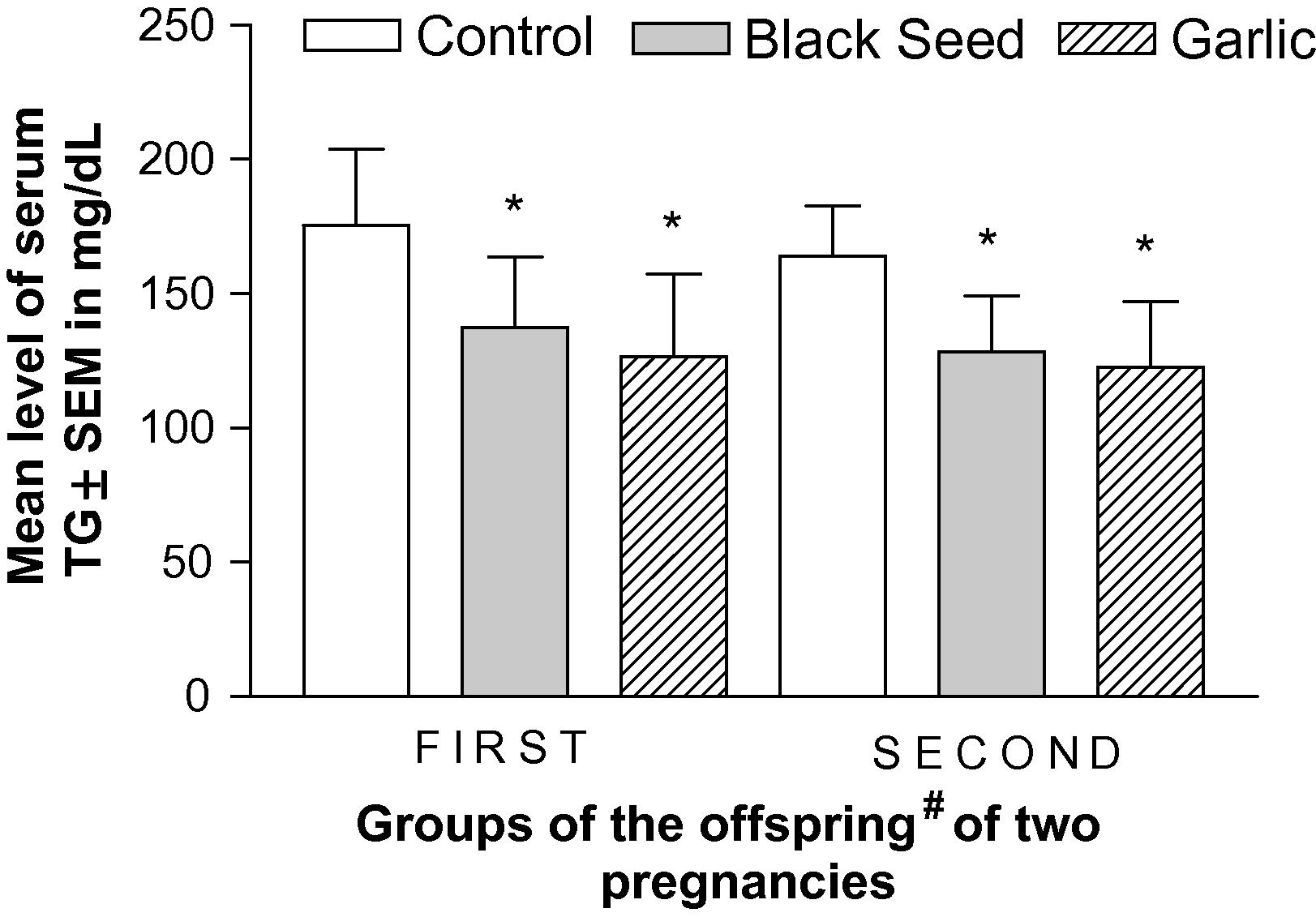
Effect of long-term consumption of black seed and garlic oils by dams on the level of triglyceride in the serum of the offspring of two consecutive pregnancies in rats. ∗ represents significantly different (p < 0.05) as compared to the control by ANOVA and Student’s t-test. #Offspring were picked at random without any consideration of gender.
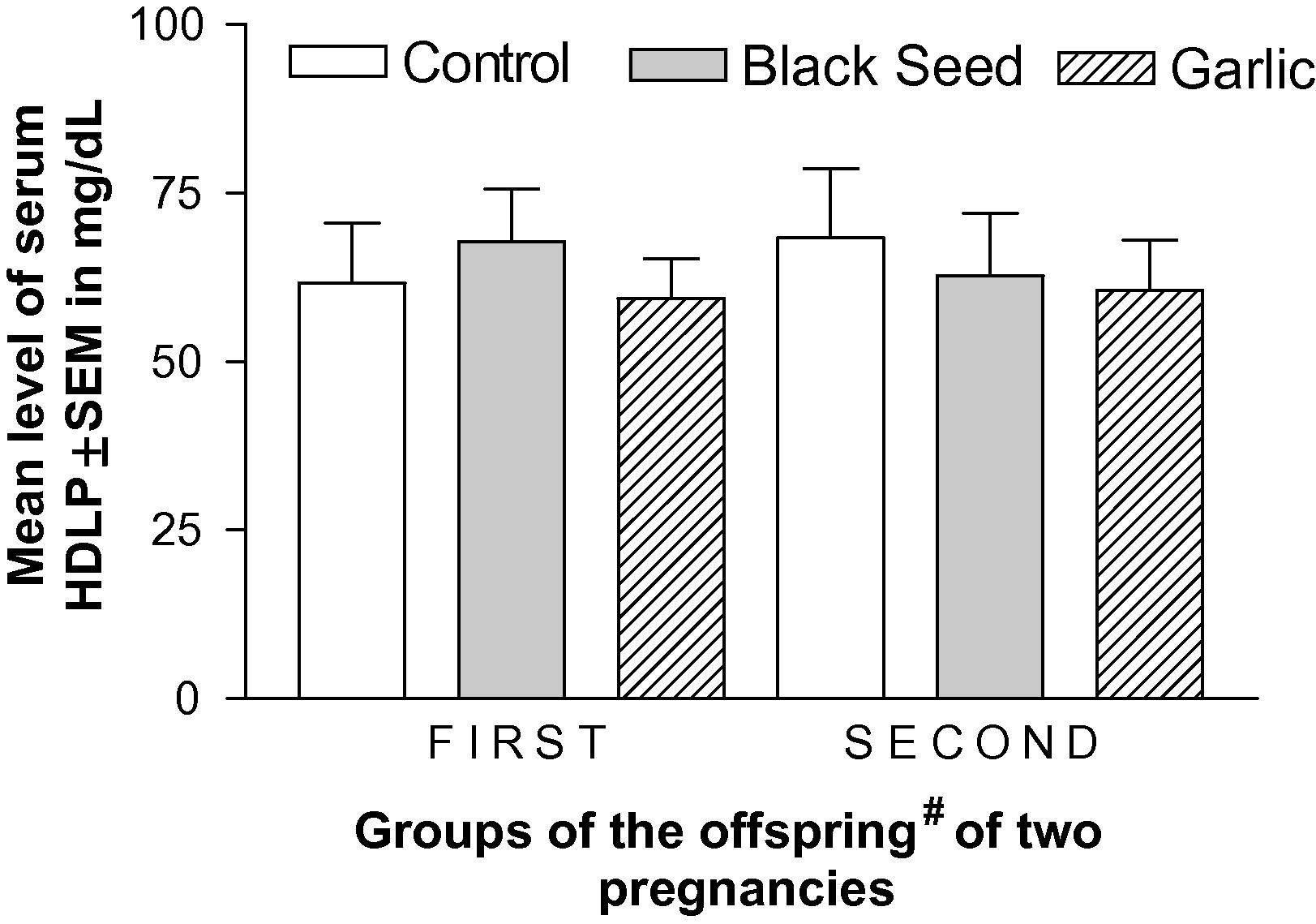
Effect of long-term consumption of black seed and garlic oils by dams on the level of cholesterol (HDLP) in the serum of the offspring of two consecutive pregnancies in rats. ∗ represents significantly different (p < 0.05) as compared to the control by ANOVA and Student’s t-test. #Offspring were picked at random without any consideration of gender.
The GOT level was significantly (p < 0.01) reduced in the offspring of treated mothers of both pregnancies (Fig. 3), however, the GPT level was reduced significantly (p < 0.01) in the offspring of mothers treated with black seed oil only and garlic had no significant effect (Fig. 4).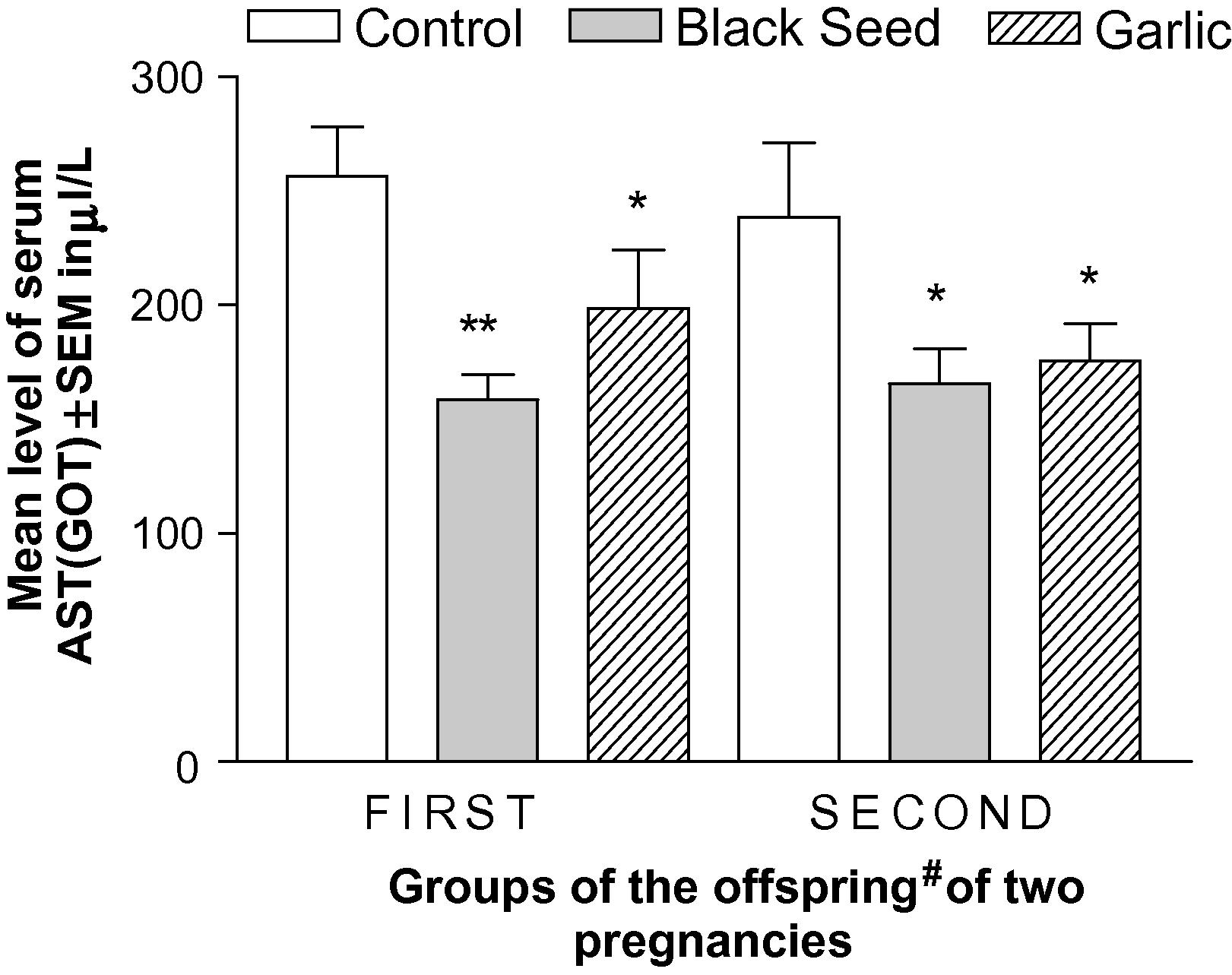
Effect of long-term consumption of black seed and garlic oils by dams on the level of GOT in the serum of the offspring of two consecutive pregnancies in rats. ∗ represents significantly different (p < 0.05) as compared to the control by ANOVA and Student’s t-test. #offspring were picked at random without any consideration of gender.
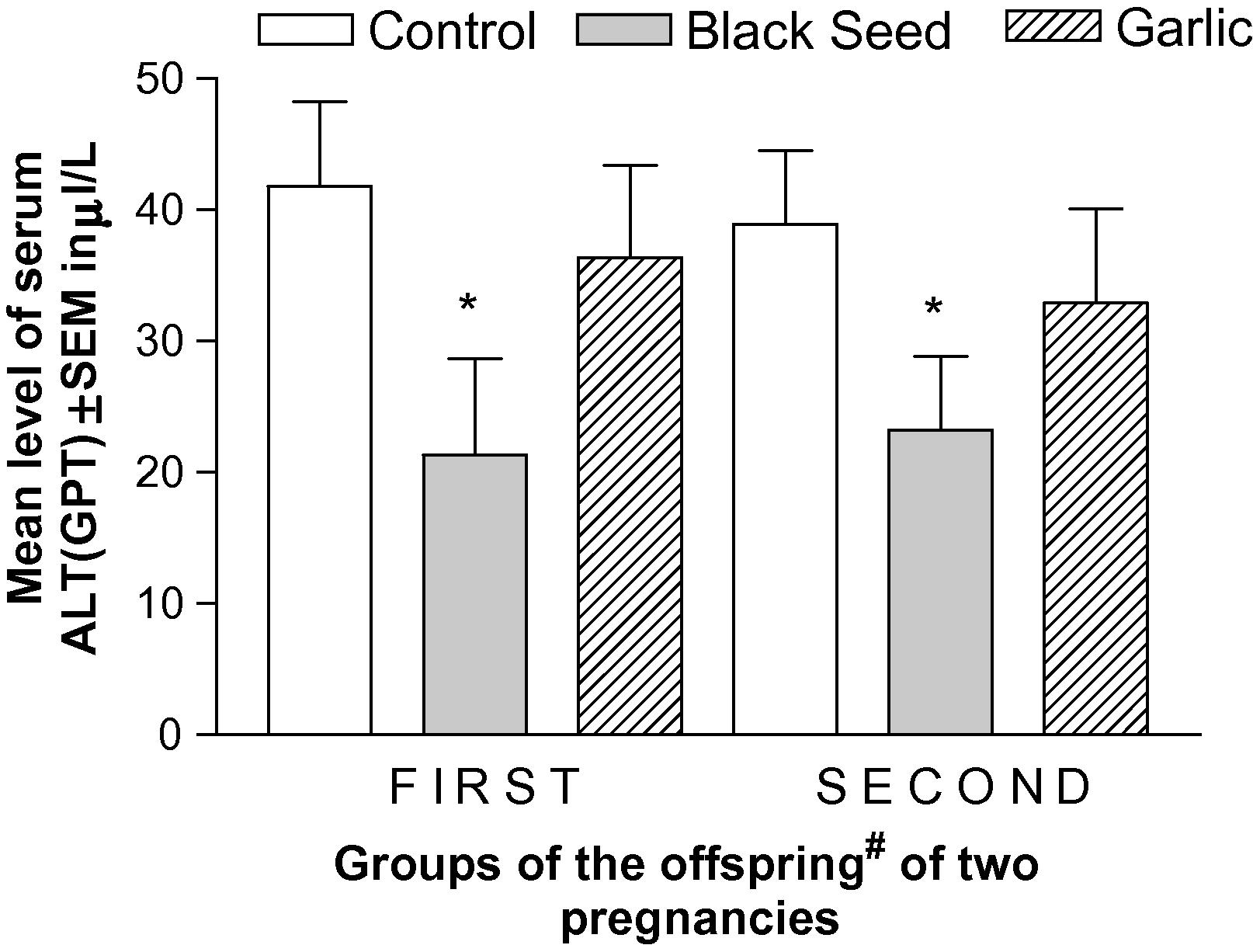
Effect of long-term consumption of black seed and garlic oils by dams on the level of GPT in the serum of the offspring of two consecutive pregnancies in rats. ∗ represents significantly different (p < 0.05) as compared to the control by ANOVA and Student’s t-test. #Offspring were picked at random without any consideration of gender.
The glucose level in the serum of the treated offspring showed a significant decline (p < 0.01) in the offspring of both pregnancies (Fig. 5), indicating that both black seed and garlic oils consumed by mothers had a lowering effect in the glucose level of the offspring of both pregnancies (Table 3). ∗ and ∗∗ represents significantly different (p < 0.01 and p < 0.001, respectively) as compared to the control by one-way ANOVA and Student’s t-test.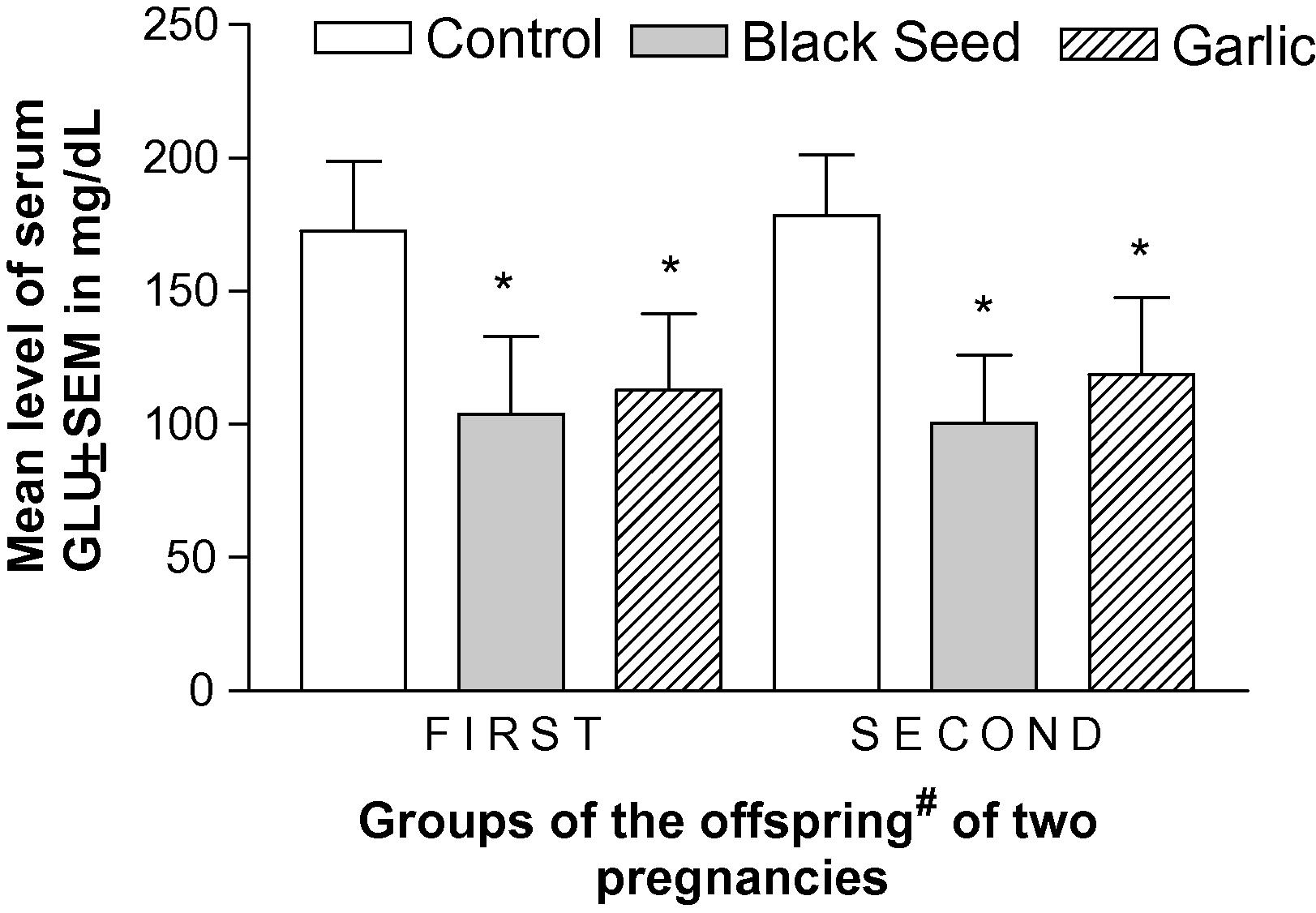
Effect of long-term consumption of black seed and garlic oils by dams on the level of glucose (GLU) in the serum of the offspring of two consecutive pregnancies in rats. ∗ represents significantly different (p < 0.05) as compared to the control by ANOVA and Student’s t-test. #Offspring were picked at random without any consideration of gender.
Experimental groups
Median value (with ranges) of various indices of locomotory activities of male offspring
First pregnancy
Second pregnancy
Number of
Duration in seconds
Number of
Duration in seconds
Squares crossed
Rears
Wall rear
Locomotion
Immobility
Squares crossed
Rears
Wall rear
Locomotion
Immobility
Control
110 (105–115.0)
6.0 (5.0–7.0)
3.0 (2.0–5.0)
180.0 (175.0–190.0)
120.0 (110.0–125.0)
117 (112.0–125.0)
6.0 (5.0–7.0)
4.0 (3.0–6.0)
192.5 (180.0–200.0)
107.5 (100.0–120.0)
Black seed
115 (110–120)
9.0∗ (8.0–12.0)
5.5∗ (5.0–7.0)
200.0∗∗ (200.0–210.0)
95.0∗ (90.0–100.0)
125∗∗ (121–132.0)
9.5 (7.0–14.0)
6.0∗ (4.0–8.0)
220.0∗ (210.0–225.0)
80.0∗ (75.0–90.0)
Garlic
122∗∗ (115–128)
10.0∗∗ (10.0–15.0)
5.0∗ (3.0–6.0)
205.0∗∗ (200.0–210.0)
98.0∗∗ (85.0–100.0)
122.5∗ (118–130.0)
11.0 (8.0–16.0)
5.0∗ (4.0–7.0)
212.5∗ (200.0 225.0)
87.0∗ (75.0–100.0)
4 Discussion
The present study was undertaken to provide comparative results on the effects of long-term consumption of black seed and garlic by the female rats on their offspring. Further, the testing and investigations of all parameters in the offspring were conducted for two consecutive pregnancies. This was done in order to verify if the observed effects due to these two folk medicines of plant origin influenced the offspring by reaching them in utero through the placenta and/or through their mother’s milk during lactation. The present results suggest that females consuming black seed and garlic oils before and during pregnancies may have beneficial effects on the offspring. At the same time black seed and garlic consumption by the dams for long time may not be toxic to them since no toxicity of these substances have been reported even after long-term exposure (Sumiyoshi et al., 1984; Akhondian et al., 2007). These two oils increased the fecundity of the offspring; however, black seed had a comparatively higher significant effect as compared to garlic. Furthermore, it was interestingly noted that black seed increased the birth of male offspring in both pregnancies as compared to females. This observation on increased fecundity as well as on the birth of increased number of male offspring after black seed consumption by the dams is reported for the first time. Thus, it is difficult to compare the present results with any other earlier reported results on these lines. However, it can be inferred upon from the present study that presence of black seed oil and/or its constituents in the diet of mothers before and during pregnancies may increase the possibility of conceiving male fetuses at a higher ratio as compared to females. Further studies, however, on a larger population needs to be carried out to confirm this preliminary observation. The fecundity data of the present study also indicate that females consuming black seed and garlic before and during pregnancy may result into a higher number of offspring which are at an advantage of receiving various beneficial effects of these folk medicines as compared to the controls.
The results of behavioural observations of the offspring of both consecutive pregnancies indicate that offspring exposed perinatally to black seed and garlic, perform better in their locomotory activities as compared to the controls. Although such beneficial effect of black seed on behavioural performance of offspring has been reported for the first time, the effect of garlic consumption on better physical performance and learning behaviour has been reported earlier in rats (Sookvanichsilp et al., 2002).
Furthermore, the level of various blood chemistry parameters tested in these offspring also indicated that perinatally exposed offspring to black seed and garlic oils, exhibited healthier levels of various biomarker chemical parameters in their serum. Altogether, these results suggest that the offspring are exposed to the beneficial constituents of perinatally consumed black seed and garlic in utero and/or through their mother’s milk during lactation period. It is now a well established fact that significant quantities of compounds that are given to the dams during late pregnancy may be transmitted to the offspring through placenta in utero and/or through milk during lactation (Ordy et al., 1966; Fabro and Sieber, 1969; Mereu et al., 1987; Ajarem and Ahmad, 1991, 1998).
Thymoquinone is the most active and abundant constituent of black seed oil (Hosseinzadeh et al., 2007) that may act as an anti-oxidant agent and prevent any oxidative injury in response to oxidative stress (Mansour et al., 2002; Altan et al., 2007). On the other hand, S-allylcysteine is the most abundant organosulfur molecule present in garlic oil (Perez-Severiano et al., 2004b) and its anti-oxidant properties have also been widely recognized (Peng et al., 2002; Ito et al., 2003; Perez-Severiano et al., 2004b). Furthermore, based on the toxicity studies of black seed and garlic, it has been reported that no toxic signs have been observed in rodents due to either black seed consumed via stomach (Akhondian et al., 2007) or garlic consumed for 6 months (Sumiyoshi et al., 1984).
Thus it is concluded that taking in due consideration of all the beneficial properties described above for black seed and garlic on different experimental models of systemic and central diseases, these two indigenous plant sources of herbal therapies may be beneficial to the offspring if consumed by their mothers before and during pregnancies. Furthermore, consumption of black seed by the dams may increase the chances of giving the birth of male offspring at a higher ratio than the females. Offspring exposed to black seed and garlic oil during perinatal period is beneficial to the offspring since they perform better in their behavioural activities and the level of their blood chemical parameters also indicate for their good health. However, further studies on a larger sample of animals are warranted to explore the present findings on the beneficial effects of black seed and garlic on the offspring.
References
- Herbal medicine in Jordan with special emphasis on commonly used herbs. J. Ethnopharmacol.. 2003;89:193-197.
- [Google Scholar]
- Anti-tumor properties of blackseed (Nigella sativa L.) extracts. Braz. J. Med. Biol. Res.. 2007;40:839-847.
- [Google Scholar]
- Studies on the effects of alcohol on locomotion activity and immobility in male mice. Proc. Saudi Biol. Soc.. 1987;97:104.
- [Google Scholar]
- Behavioural and biochemical consequences of perinatal exposure of mice to instant coffee: a correlative evaluation. Pharmacol. Biochem. Behav.. 1991;40:847-852.
- [Google Scholar]
- Effects of perinatal exposure of mice to non-alcoholic malt beverage “beer” on the offspring. Saudi J. Biol. Soc.. 1998;5:78-91.
- [Google Scholar]
- The effect of Nigella sativa L. (blackcumin seed) on intractable pediatric seizures. Med. Sci. Monit.. 2007;13:CR555-CR559.
- [Google Scholar]
- Pharmacological and toxicological properties of Nigella sativa. Phytother. Res.. 2003;17:299-305.
- [Google Scholar]
- Combination therapy of Nigella sativa and human parathyroid hormone on bone mass, biomechanical behavior and structure in streptozotocin-induced diabetic rats. Acta Histochem.. 2007;109:304-314.
- [Google Scholar]
- Therapeutic values of onion (Allium cepa L.) and garlic (Allium sativum L.) Indian J. Exp. Biol.. 1996;34:634-640.
- [Google Scholar]
- Caffeine and nicotine penetrate the pre-implantation blastocyte. Nature. 1969;223:410-411.
- [Google Scholar]
- Effect of thymoquinone and Nigella sativa seeds oil on lipid peroxidation level during global cerebral ischemia-reperfusion injury in rat hippocampus. Phytomedicine. 2007;14:621-627.
- [Google Scholar]
- Neurotoxicity induced by amyloid beta-peptide and ibotenic acid in organotypic hippocampal cultures: protection by S-allyl-l-cysteine, a garlic compound. Brain Res.. 2003;985:98-107.
- [Google Scholar]
- Hepatoprotective effects of Nigella sativa L. and Urtica dioica L. on lipid peroxidation, antioxidant enzyme systems and liver enzymes in carbon tetrachloride-treated rats. World J. Gastroenterol.. 2005;11:6684-6688.
- [Google Scholar]
- Effects of aqueous extracts of medicinal plants on MNNG-treated rat hepatocytes in primary cultures. J. Ethnopharmacol.. 2007;112:199-202.
- [Google Scholar]
- Differential regulation of NO availability from macrophages and endothelial cells by the garlic component S-allyl cysteine. Free Radic. Biol. Med.. 2001;30:747-756.
- [Google Scholar]
- Effects of thymoquinone on antioxidant enzyme activities, lipid peroxidation and DT-diaphorase in different tissues of mice. A possible mechanism of action. Cell Biochem. Funct.. 2002;20:143-151.
- [Google Scholar]
- Preferential stimulation of ventral tegmental area dopaminergic neurons by nicotine. Eur. J. Pharmacol.. 1987;141:395-399.
- [Google Scholar]
- Ameliorative effect of S-allylcysteine, a major thioallyl constituent in aged garlic extract, on learning deficits in senescence-accelerated mice. J. Nutr.. 2001;131:1093-1095.
- [Google Scholar]
- S-Allylcysteine inhibits free radical production, lipid peroxidation and neuronal damage in rat brain ischemia. J. Nutr.. 2001;131:1100-1105.
- [Google Scholar]
- Prenatal chlorpromazine effects on liver, survival and behaviour of mice offspring. J. Pharmacol. Exp. Thera.. 1966;151:110-125.
- [Google Scholar]
- Garlic ameliorates gentamicin nephrotoxicity: relation to antioxidant enzymes. Free Radic. Biol. Med.. 2000;29:602-611.
- [Google Scholar]
- Neuroprotective effect of garlic compounds in amyloid-beta peptide-induced apoptosis in vitro. Med. Sci. Monit.. 2002;8:328-337.
- [Google Scholar]
- S-Allylcysteine prevents amyloid-beta peptide-induced oxidative stress in rat hippocampus and ameliorates learning deficits. Eur. J. Pharmacol.. 2004;489:197-202.
- [Google Scholar]
- S-Allylcysteine, a garlic-derived antioxidant, ameliorates quinolinic acid-induced neurotoxicity and oxidative damage in rats. Neurochem. Int.. 2004;45:1175-1183.
- [Google Scholar]
- Ethnopharmacological survey of medicinal herbs in Israel, the Golan Heights and the West Bank region. J. Ethnopharmacol.. 2002;83:251-265.
- [Google Scholar]
- Biometry: The Principles and Practice of Statistics in Biological Research. San Francisco, WH: Freeman; 1981.
- Effects of raw garlic on physical performance and learning behaviour in rats. Phytother. Res.. 2002;16:732-736.
- [Google Scholar]
- Methods in drugs development. In: De Vita Jr., Busch H., eds. Drugs of Plant Origin. New York: Academic Press; 1982.
- [Google Scholar]
- Traditional medicine – growing needs and potential. WHO Policy Perspect. Med.. 2002;2:1-6.
- [Google Scholar]
- The t-distribution. In: Yamane T., ed. Statistics and Introductory Analysis (third ed.). London: Harper and Row; 1973. p. :647-650.
- [Google Scholar]







